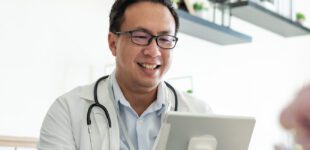November 11, 2019
The world is an increasingly busy place, and scheduling that appointment with your doctor for a check up might be on the end of your to-do list. As new technologies enter into the world of health and medicine, it is becoming increasingly easier to check your own vitals to ensure you’re living the healthiest lifestyle possible.
Enter IEEE Member Yangong Zheng and the electronic nose technology being used to detect and diagnose diseases and disorders simply through the smell your body emits. Although the biological olfactory system was inspiration for this type of technology, an electronic nose does not physically look like or depict a human nose.
“Artificial systems for noninvasive chemical sensing are commonly referred to as ‘electronic nose technology’,” explains Zheng.
See also Meet the E-Nose That Actually Sniffs
How Does Electronic Nose Technology Work?
Electronic noses use chemical sensors to detect metal oxides or conducting polymers.
“The electronic nose is a multisensory system employed in the analysis of a complex gas environment that transforms raw data into specific recognition patterns for qualitative or quantitative recognition through computational and statistical analysis,” says Zheng. “Therefore, the components of electronic noses typically combine a sampling system, a sensor array and a pattern classifier.”
Pattern recognition takes the sensor data and extracts the informative features of the gas components in order for the electronic nose to detect the suspicious smells.
“The goal for pattern recognition is classified to qualitative or quantitative analysis,” says Zheng. “Qualitative analysis is to distinguish the species of gas, and quantitative analysis is to estimate the concentration of gas.”
The electronic nose technology also uses a variety of machine learning algorithms and integrated AI components for accurate detection.
“Many machine learning algorithms were widely integrated with the electronic nose for qualitative analysis, such as artificial neural networks, probabilistic neural networks, self-organizing maps, deep learning, decision trees, support vector machines and principal component analysis,” says Zheng.
See also Improving the Quality of Sleep with AI and Machine Learning
Disease and Disorder Diagnosis
While the sensor also has the ability to detect food quality, environmental pollution and indoor air monitoring, one of the most vital areas for this research has been the sensor’s ability to use human odor recognition for medical diagnosis.
“Human odor, which results from internal hormonal or metabolic changes, is found to contain a biomarker for certain diseases and reflects the physiological status of an individual,” says Zheng. “The major sources of human odor are breath, saliva, sweat, skin and urine. Recently, the components of exhaled breath, skin emissions and urine odor have attracted attention as diagnostic biomarkers of diseases and disorders, such as diabetes, liver disease, asthma, lung cancer and chronic obstructive pulmonary disease and cystic fibrosis.”
Zheng programmed the gas sensor to detect a variety of different gases that could indicate your vitals are at a concerning level in a matter of minutes.
“Generally, the gas sensor has a broad spectrum to gases,” says Zheng. “Volatile organic compounds (VOCs) are the major target for the electronic nose in the medical diagnosis, such as acetone for patients with diabetes, ammonia in individuals with liver disease, pentane in patients with asthma and alkanes in patients with lung cancer.”
While the electronic nose technology has the potential to be used for diagnosis and as an indicator of overall health, Zheng reiterates that it is is not yet mature enough to perform a full diagnosis. Once a detection indicates a warning, visit a doctor to get a full analysis of your health condition. Once we have a little more knowledge on our side, finding the motivation to finally make that doctor appointment might be a lot easier.






 Meaningful Momentum or Running in Place?
Meaningful Momentum or Running in Place? AI Through Our Ages
AI Through Our Ages Liquid Infrastructure: Our Planet's Most Precious Resource
Liquid Infrastructure: Our Planet's Most Precious Resource The Impact of Technology in 2025
The Impact of Technology in 2025 Quantum and AI: Safeguards or Threats to Cybersecurity?
Quantum and AI: Safeguards or Threats to Cybersecurity? Why AI Can't Live Without Us
Why AI Can't Live Without Us Bits, Bytes, Buildings and Bridges: Digital-Driven Infrastructure
Bits, Bytes, Buildings and Bridges: Digital-Driven Infrastructure Impact of Technology in 2024
Impact of Technology in 2024 Emerging AI Cybersecurity Challenges and Solutions
Emerging AI Cybersecurity Challenges and Solutions The Skies are Unlimited
The Skies are Unlimited Smart Cities 2030: How Tech is Reshaping Urbanscapes
Smart Cities 2030: How Tech is Reshaping Urbanscapes Impact of Technology 2023
Impact of Technology 2023 Cybersecurity for Life-Changing Innovations
Cybersecurity for Life-Changing Innovations Smarter Wearables Healthier Life
Smarter Wearables Healthier Life Infrastructure In Motion
Infrastructure In Motion The Impact of Tech in 2022 and Beyond
The Impact of Tech in 2022 and Beyond Cybersecurity, Technology and Protecting Our World
Cybersecurity, Technology and Protecting Our World How Technology Helps us Understand Our Health and Wellness
How Technology Helps us Understand Our Health and Wellness The Resilience of Humanity
The Resilience of Humanity Harnessing and Sustaining our Natural Resources
Harnessing and Sustaining our Natural Resources Creating Healthy Spaces Through Technology
Creating Healthy Spaces Through Technology Exceptional Infrastructure Challenges, Technology and Humanity
Exceptional Infrastructure Challenges, Technology and Humanity The Global Impact of IEEE's 802 Standards
The Global Impact of IEEE's 802 Standards Scenes of our Cyber Lives: The Security Threats and Technology Solutions Protecting Us
Scenes of our Cyber Lives: The Security Threats and Technology Solutions Protecting Us How Millennial Parents are Embracing Health and Wellness Technologies for Their Generation Alpha Kids
How Millennial Parents are Embracing Health and Wellness Technologies for Their Generation Alpha Kids Space Exploration, Technology and Our Lives
Space Exploration, Technology and Our Lives Global Innovation and the Environment
Global Innovation and the Environment How Technology, Privacy and Security are Changing Each Other (And Us)
How Technology, Privacy and Security are Changing Each Other (And Us) Find us in booth 31506, LVCC South Hall 3 and experience the Technology Moon Walk
Find us in booth 31506, LVCC South Hall 3 and experience the Technology Moon Walk Virtual and Mixed Reality
Virtual and Mixed Reality How Robots are Improving our Health
How Robots are Improving our Health IEEE Experts and the Robots They are Teaching
IEEE Experts and the Robots They are Teaching See how millennial parents around the world see AI impacting the lives of their tech-infused offspring
See how millennial parents around the world see AI impacting the lives of their tech-infused offspring Take the journey from farm to table and learn how IoT will help us reach the rising demand for food production
Take the journey from farm to table and learn how IoT will help us reach the rising demand for food production Watch technical experts discuss the latest cyber threats
Watch technical experts discuss the latest cyber threats Explore how researchers, teachers, explorers, healthcare and medical professionals use immersive technologies
Explore how researchers, teachers, explorers, healthcare and medical professionals use immersive technologies Follow the timeline to see how Generation AI will be impacted by technology
Follow the timeline to see how Generation AI will be impacted by technology Learn how your IoT data can be used by experiencing a day in a connected life
Learn how your IoT data can be used by experiencing a day in a connected life Listen to technical experts discuss the biggest security threats today
Listen to technical experts discuss the biggest security threats today See how tech has influenced and evolved with the Games
See how tech has influenced and evolved with the Games Enter our virtual home to explore the IoT (Internet of Things) technologies
Enter our virtual home to explore the IoT (Internet of Things) technologies Explore an interactive map showcasing exciting innovations in robotics
Explore an interactive map showcasing exciting innovations in robotics Interactively explore A.I. in recent Hollywood movies
Interactively explore A.I. in recent Hollywood movies Get immersed in technologies that will improve patients' lives
Get immersed in technologies that will improve patients' lives